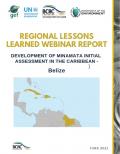This study introduces an approach for assessing the combined risk to marine habitats from multiple human activities, and applies it to coral reefs, mangrove forests, and seagrass beds in Belize to inform the design of the country’s first Integrated Coastal Zone Management (ICZM) Plan. The authors map the current distribution of coastal and ocean activities and develop three scenarios for zoning these activities. They then estimate ecosystem risk under the current and three future scenarios. Current levels of risk vary spatially among the nine coastal planning regions in Belize.
The study finds that, compared to the current scenario, the future scenario that harmonizes conservation and development goals results in a 20 percent reduction in the area of high-risk habitat while also increasing the extent of several ocean uses. These results were used to inform a component of Belize’s ICZM Plan, and the application of this model illustrates an approach that can be used broadly by coastal and ocean planners across the globe to assess risk to habitats.


